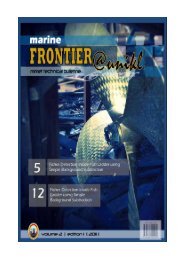click here to download - UniKL MIMET Official Website
click here to download - UniKL MIMET Official Website
click here to download - UniKL MIMET Official Website
Create successful ePaper yourself
Turn your PDF publications into a flip-book with our unique Google optimized e-Paper software.
METHODOLOGY<br />
Description of Apparatus<br />
To achieve the desired outcomes, various<br />
apparatus are required, namely for diffusion<br />
bonding and post‐bond heat treatment.<br />
Apparatus for Diffusion Bonding<br />
The apparatus for diffusion bonding is de‐<br />
signed <strong>to</strong> provide compressive loading (pressing)<br />
and heating in a vacuum at the interface of a<br />
specimen <strong>to</strong> be joined. The configuration of the<br />
working part of the apparatus is shown at Fig. 3.<br />
Apparatus for Post‐Bond Heat Treatment<br />
This apparatus is designed <strong>to</strong> carry out post‐<br />
bond heat treatment for further diffusion<br />
processes <strong>to</strong> takes place in the diffusion cou‐<br />
ples obtained by diffusion bonding. A sche‐<br />
matic drawing of the annealing furnace, vac‐<br />
uum chamber, specimen and its mounting is<br />
shown in Fig. 5.<br />
<strong>MIMET</strong> Technical Bulletin Volume 1 (2) 2010<br />
Materials and Specimen Preparation for Diffu‐<br />
sion Bonding.<br />
Materials used in this study as parent metals<br />
are commercial grade aluminum and steel with<br />
various carbon contents. These materials are<br />
cut in a lathe <strong>to</strong> cylindrical specimen of sizes;<br />
12 mm diameter by 10 mm length, and 14 mm<br />
diameter by 20 mm length for metallographic<br />
observation and tensile test specimens respec‐<br />
tively. This specimen and their assembly are<br />
shown in Fig. 6 and Fig.7 respectively. 4.3<br />
Bonding Procedure<br />
The specimens are positioned in the apparatus<br />
as shown in Fig. 3. The temperature used for the<br />
metallographic specimens is 600°C and for tensile<br />
specimen are 500°C, 550°C and 600°C. The bonding<br />
of these specimens is conducted under a dynamic<br />
vacuum pressure of the order of 10‐2 Torr for 30<br />
minute with bonding pressure of 0.5 kgf/mm.<br />
| MARINE FRONTIER @ <strong>UniKL</strong><br />
71



